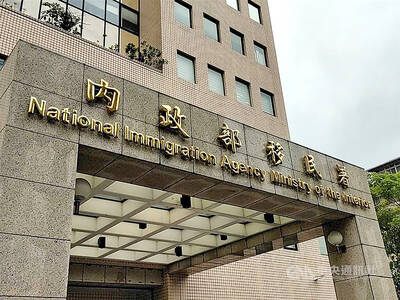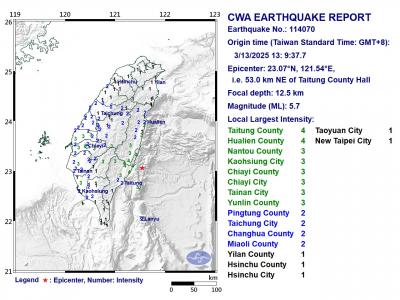Citing a lack of resources, finances, and certified teachers and materials, teachers of the country’s native languages — including Hoklo (also known as Taiwanese), Hakka and Aboriginal languages — yesterday accused the government of not putting enough efforts into native-language education.
“It’s been 10 years since we started the nationwide mother-tongue education program, but I don’t see it getting any better. Instead, it’s moving backwards,” Taiwan Mother Language Teachers’ Association chairman Huang Hsiu-jen (黃修仁) said at a public hearing hosted by Democratic Progressive Party legislators Wu Ping-jui (吳秉叡) and Chen Ou-po (陳歐珀) on native-language education at the Legislative Yuan yesterday.
“Ten years ago, there was a budget of NT$40,000 to NT$50,000 [US$1,335 to US$1,669] per month per school, but the money has been cut to a little more than NT$20,000,” he added. “How can we hire well-trained language teachers with that little money?”
As a result, many schools have asked for non-professional language teachers to teach native-language classes, Huang said.
“For example, the teacher who teaches the Hoklo class at my child’s school does not speak Hoklo at home and he barely knows the language,” he said. “What can we expect from such classes?”
Taiwanese Language Association of Taipei City chairman Lee Po-tung (李柏桐) said that many teachers who do not speak Hoklo well, but are assigned to teach the language, have complained to him.
“This is difficult for both students and teachers,” Lee said. “Some teachers don’t know how to teach such classes, so all they do is play the language instruction CDs out loud in class, that’s it.”
Lee said that according to regulations, a teacher may teach a beginner’s level mother-tongue class after completing 36 hours of training, and a higher-level class after a 72-hour training course.
“You don’t learn to speak a language in 36 or 72 hours,” Lee said.
Taiwan Hakka Teachers’ Association chairwoman Chuang Chen Yueh-hsiu (莊陳月琇) said that whenever her daughter-in-law, a Hakka, is to teach a Hoklo class, “I have to give her a lesson before she gives a lesson to her students — this is ridiculous.”
National Taiwan Normal University’s Department of Taiwanese Culture, Languages and Literature chairman Li Khin-huann (李勤岸) urged the government to reinstate the mother-tongue teacher certification system.
“In 2009, the government voided a regulation that requires teachers to obtain certification in the target language before teaching it. I don’t think this makes any sense,” Li said. “I strongly urge the government to reinstate the regulation, so that the quality of language teachers could be guaranteed.”
Indigenous Teachers’ Association of Taipei City chairman Upah Yuki said the situation is even worse for Aboriginal languages.
“We simply don’t have any resources,” he said. “I’m always jealous to see stacks of printed Hakka or Hoklo vocabulary cards at school, while we Aboriginal-language teachers have to make our own.”
Upah said the education authorities seem to think that there is only one Aboriginal tribe, because most schools provide only Amis classes.
“I’m an Atayal and when a relative sent his kid to Aboriginal language class at Taishan Elementary School in New Taipei City (新北市), he came home and only knew to say ngaiho,” Upah said, adding that ngaiho is Amis for “hello.”
Li said that language education is too complicated for the National Languages Committee to handle.
“We need a Cabinet-level ministry or council to handle mother-tongue affairs,” he said.

CAUTION: Based on intelligence from the nation’s security agencies, MOFA has cautioned Taiwanese travelers about heightened safety risks in China-friendly countries The Ministry of Foreign Affairs (MOFA) yesterday urged Taiwanese to be aware of their safety when traveling abroad, especially in countries that are friendly to China. China in June last year issued 22 guidelines that allow its courts to try in absentia and sentence to death so-called “diehard” Taiwanese independence activists, even though Chinese courts have no jurisdiction in Taiwan. Late last month, a senior Chinese official gave closed-door instructions to state security units to implement the guidelines in countries friendly to China, a government memo and a senior Taiwan security official said, based on information gathered by Taiwan’s intelligence agency. The

The National Immigration Agency (NIA) said yesterday that it will revoke the dependent-based residence permit of a Chinese social media influencer who reportedly “openly advocated for [China’s] unification through military force” with Taiwan. The Chinese national, identified by her surname Liu (劉), will have her residence permit revoked in accordance with Article 14 of the “Measures for the permission of family- based residence, long-term residence and settlement of people from the Mainland Area in the Taiwan Area,” the NIA said in a news release. The agency explained it received reports that Liu made “unifying Taiwan through military force” statements on her online

Taiwan Semiconductor Manufacturing Co (TSMC), the world’s largest contract chipmaker, said yesterday that it is looking to hire 8,000 people this year, at a time when the tech giant is expanding production capacity to maintain its lead over competitors. To attract talent, TSMC would launch a large-scale recruitment campaign on campuses across Taiwan, where a newly recruited engineer with a master’s degree could expect to receive an average salary of NT$2.2 million (US$60,912), which is much higher than the 2023 national average of NT$709,000 for those in the same category, according to government statistics. TSMC, which accounted for more than 60 percent

A magnitude 5.7 earthquake struck off Taitung County at 1:09pm today, the Central Weather Administration (CWA) said. The hypocenter was 53km northeast of Taitung County Hall at a depth of 12.5km, CWA data showed. The intensity of the quake, which gauges the actual effect of a seismic event, measured 4 in Taitung County and Hualien County on Taiwan's seven-tier intensity scale, the data showed. The quake had an intensity of 3 in Nantou County, Chiayi County, Yunlin County, Kaohsiung and Tainan, the data showed. There were no immediate reports of damage following the quake.